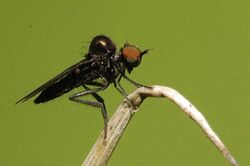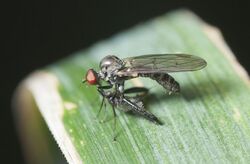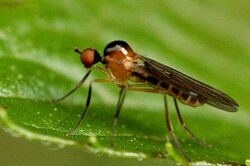Biology:Hybotidae
| Hybotidae | |
|---|---|

| |
| Bicellaria spuria (Ocydromiinae: Bicellariini) | |
| Scientific classification | |
| Domain: | Eukaryota |
| Kingdom: | Animalia |
| Phylum: | Arthropoda |
| Class: | Insecta |
| Order: | Diptera |
| Suborder: | Brachycera |
| Infraorder: | Asilomorpha |
| Superfamily: | Empidoidea |
| Family: | Hybotidae Macquart, 1823 |
| Subfamilies | |
Hybotidae, the typical dance flies, are a family of true flies. They belong to the superfamily Empidoidea and were formerly included in the Empididae as a subfamily.
Some, such as Tachydromia, are predators that run around on the bark of trees in complex patterns, hence the common name. Tachydromia species are only about three millimeters long.
Description
File:Hybos caliciformis (Hybotidae).tif Hybotidae share some similarities with the family Dolichopodidae, when looking at rotation of genitalia and wing characteristics. Male terminalia are rotated dextrally between 45° and 90°, excluding segment 7. Hybotidae wings always have a simple R4+5 vein, where the costa either ends near or at M1/M1+2, or near or at R4+5/R5. Furthermore, it can be distinguished from Dolichopodidae by the point of vein Rs, which it at a distance from the humeral crossvein (h) equal to or longer than the length of h.[1]
Systematics
The Hybotidae clearly form a lineage quite distinct from the Empididae. Among the Empidoidea, they represent a lineage more basal than the main radiation of Empididae and Dolichopodidae, though they are not as ancient as the genera placed in the Atelestidae.[2][3]
By and large, the Hybotidae are monophyletic. Among its subfamilies, the Hybotinae and Tachydromiinae certainly represent clades. The status of the Ocydromiinae as a natural group is less clear, in particular whether the Trichininae should be included as tribe Trichinini or even in the Bicellariini[4] or Oedaleini,[5] or whether they are more distinct and warrant recognition as a separate subfamily.[2]
Based on the most recent phylogenetic studies,[1] the relationship between Hybotidae and other members of Empidoidea is as follows. The placement of Hybotidae is emphasized in bold formatting.
| Atelestidae |
| ||||||||||||||||||||||||||||||||||||||||||||||||||||||||||||||||||||||||||||||||||||||||||||||||||||||||||||
| |||||||||||||||||||||||||||||||||||||||||||||||||||||||||||||||||||||||||||||||||||||||||||||||||||||||||||||
Systematic list
The subfamilies with their tribes and selected genera are:[3][6][7]

- Acarterus Loew, 1858
- Afrohybos Smith, 1967
- Ceratohybos Bezzi
- Chillcottomyia Saigusa, 1986
- Euhybus Coquillett, 1895
- †Eternia Martins-Neto et al. 1992 Tremembé Formation, Brazil, Chattian
- Hybos Meigen, 1803
- Lactistomyia Melander, 1902
- Lamachella Melander, 1928
- Neohybos Ale-Rocha & Carvalho, 2003
- Parahybos Kertész, 1899
- †Pseudoacarterus Waters 1989 Orapa, Botswana, Turonian
- Smithybos Ale-Rocha, 2000
- Stenoproctus Loew, 1858
- Syndyas Loew, 1857
- Syneches Walker, 1852
- †Syneproctus Solórzano-Kraemer et al. 2020 Dominican amber, Miocene

- Tribe Bicellariini Sinclair & Cumming, 2006[9]
- Bicellaria Macquart, 1823
- Hoplocyrtoma
- Leptocyrtoma
- Tribe Ocydromiini
- Leptodromiella Tuomikoski, 1936
- Leptopeza Macquart, 1834
- Ocydromia Meigen, 1820
- Oropezella Collin, 1926
- Tribe Oedaleini Chvála, 1983
- Allanthalia Melander, 1927
- Anthalia Zetterstedt, 1838
- Euthyneura Macquart, 1836
- Oedalea Meigen, 1820
- †Ecommocydromia Schlüter 1978 Bezonnais amber, France, Cenomanian
- †Pouillonhybos Ngô-Muller et al. 2020, Burmese amber, Myanmar, Cenomanian
File:Trichinomyia flavipes - 2014-09-08.webm Trichininae (often included in Ocydromiinae)
- Trichina Meigen, 1830[10]
- Trichinomyia Tuomikoski, 1959[11]
- Tribe Symballophthalmini Bradley, Sinclair & Cumming, 2006
- Symballophthalmus Becker[12], 1889
- Tribe Drapetini Collin, 1961
- Allodromia Smith, 1962
- Atodrapetis Plant, 1997
- Austrodrapetis Smith, 1964
- Austrodromia Collin, 1961
- Chaetodromia Chillcott & Teskey, 1983
- Chersodromia Haliday in Walker, 1851
- Crossopalpus Bigot, 1857
- Drapetis Meigen, 1822
- Dusmetina Gil Collado, 1930
- Elaphropeza Macquart, 1827[13][14]
- Isodrapetis Collin, 1961
- Megagrapha Melander, 1928
- Micrempis Melander, 1928
- Nanodromia Grootaert, 1994
- Ngaheremyia Plant & Didham, 2006
- Pontodromia Grootaert, 1994
- Sinodrapetis Yang, Gaimari & Grootaert, 2004
- Stilpon Loew, 1859
- Tribe Tachydromiini
- Charadrodromia Melander, 1928
- Dysaletria Loew, 1864[15]
- Pieltainia Arias, 1919[16]
- Platypalpus Macquart, 1827
- Tachydromia Meigen, 1803
- Tachyempis Melander, 1928
- Tachypeza Meigen, 1830
File:Tachypeza nubila with prey.ogv
- †Archaeodrapetiops Martins-Neto et al. 1992 Tremembé Formation, Brazil, Chattian
- †Cretoplatypalpus Kovalev 1978 Taimyr amber, Russia, Santonian, Canadian amber, Campanian
- †Electrocyrtoma Cockerell 1917 Burmese amber, Myanmar, Cenomanian
- †Mesoplatypalpus Grimaldi and Cumming 1999 Canadian amber, Campanian
Incertae sedis
- †Trichinites Hennig 1970 Lebanese amber, Barremian
References
- ↑ 1.0 1.1 Wahlberg, Emma; Johanson, Kjell Arne (2018). "Molecular phylogenetics reveals novel relationships within Empidoidea (Diptera)" (in en). Systematic Entomology 43 (4): 619–636. doi:10.1111/syen.12297. ISSN 1365-3113.
- ↑ 2.0 2.1 Moulton, J. K.; Wiegmann, B. M. (2007). "The phylogenetic relationships of flies in the superfamily Empidoidea (Insecta: Diptera).". Molecular Phylogenetics and Evolution 43 (3): 701–713. doi:10.1016/j.ympev.2007.02.029. PMID 17468014.
- ↑ 3.0 3.1 Sinclair, Bradley J.; Cumming, Jeffrey M. (2006). "The morphology, higher-level phylogeny and classification of the Empidoidea (Diptera)". Zootaxa 1180: 1–172. doi:10.11646/zootaxa.1180.1.1. ISBN 978-1-877407-80-2. http://www.uoguelph.ca/nadsfly/Doid/Doidclass/SinclairCumming2006.pdf. Retrieved 20 December 2011.
- ↑ Jere Kahanpää (July 23, 2008). "Hybotidae". Draft Catalogue of Finnish Flies (Diptera: Brachycera). http://www.elisanet.fi/~d625473/diptera/list/online/node28.html.
- ↑ "Hybotidae". Integrated Taxonomic Information System. https://www.itis.gov/servlet/SingleRpt/SingleRpt?search_topic=TSN&search_value=136392.
- ↑ Chvála, Milan (1983). The Empidoidea (Diptera) of Fennoscandia and Denmark. II. General Part. The families Hybotidae, Atelestidae and Microphoridae. Fauna Entomologica Scandinavica. 12. pp. 1–279.
- ↑ Chvála, Milan (1975). The Tachydromiinae (Diptera; Empididae) of Fennoscandia and Denmark. Fauna Entomologica Scandinavica. 3. Klampenborg: Scandinavian Science Press. pp. 1–336. ISBN 978-87-87491-04-4.
- ↑ Meigen, J.W. (1820). Systematische Beschreibung der bekannten europäische n zweiflugeligen Insekten. Aachen: Zweiter Theil. Forstmann. pp. xxxvi + 363. https://www.biodiversitylibrary.org/item/45915#page/9/mode/1up. Retrieved 8 July 2022.
- ↑ Sinclair, Bradley J.; Cumming, Jeffrey M. (2006). "Morphology, higher-level phylogeny and classification of the Empidoidea". Zootaxa (Auckland, New Zealand: Magnolia Press) 1180: 1–172. http://www.nadsdiptera.org/Doid/Doidclass/SinclairCumming2006.pdf. Retrieved 24 April 2023.
- ↑ Miroslav Barták & Štěpán Kubík (2009). "A new species of the genus Trichina (Diptera: Hybotidae) with a key to European species". https://home.czu.cz/storage/trichina.pdf.
- ↑ "Trichinomyia Tuomikoski, 1959". http://www.nhm.ac.uk/our-science/data/uk-species/species/trichinomyia.html.
- ↑ "Symballophthalmus Becker, 1889". https://species.nbnatlas.org/species/NBNSYS0000138137.
- ↑ Shamshev, I.V.; Grootaert, P. (2007). "Revision of the genus Elaphropeza Macquart (Diptera: Hybotidae) from the Oriental Region, with a special attention to the fauna of Singapore". Zootaxa 1488: 1–164. doi:10.11646/zootaxa.1488.1.1. ISSN 1175-5334. http://www.vliz.be/imisdocs/publications/238203.pdf. Retrieved 18 July 2017.
- ↑ Grootaert, Patrick; Van De Velde, Isabella; Shamshev, Igor V. (2015). "Two new coastal species of Elaphropeza Macquart (Diptera: Hybotidae) from Bali, Indonesia". European Journal of Taxonomy (112): 1–10. doi:10.5852/ejt.2015.112. ISSN 2118-9773. http://www.europeanjournaloftaxonomy.eu/index.php/ejt/article/viewFile/234/419. Retrieved 18 July 2017.
- ↑ Loew, H. (1864). "Ueber die schlesischen Arten der Gattungen Tachypeza Meig. (Tachypeza, Tachista, Dysaletria) und Microphorus Macq. (Trichina und Microphorus)". Zeitschrift für Entomologie (Breslau) 14 (1860): 1–60.
- ↑ Arias, J. E. (1919). "Description preliminar de un nuevo Empido de Espana". Boletín de la Real Sociedad Española de Historia Natural 19: 479–481.
External links
- Family description
- Images at Diptera.info
- [1] Key to UK genera
Wikidata ☰ Q594004 entry
 |



